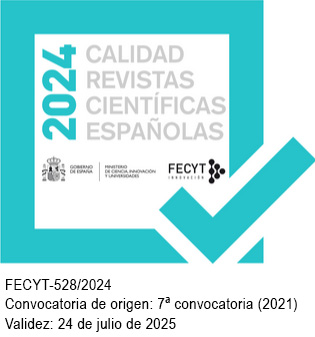States of the Art. An Introduction
doi: https://doi.org/10.31810/rsel.55.1.1
Abstract
Introducción al monográfico Los predicados estativos
Downloads
References
Arad, M. (1999). What Counts as a Class? The Case of Psych Verbs. MIT Working Papers in Linguistics, 1-23.
Arche, M. J. (2006). Individuals in Time. Tense, Aspect and the individual/stage distinction. Amsterdam: John Benjamins.
Bennett, M. y Partee, B. (1972). Toward the logic of tense and aspect in English. Bloomington, IN: IULC.
Carlson, G. N. (1977). Reference to Kinds in English. Tesis doctoral, University of Massachussetts, Amherst.
Comrie, B. (1976) Aspect. Cambridge: Cambridge University Press.
Chabot, D. (2007). Individual-level predicates and when-conditionals. Tesina de máster, Universiteit van Amsterdam.
Coll-Florit, M., Castellón Masalles, I. y Climent, S. (2008). Sobre la natura dels estats: una revisió basada en corpus. Sintagma: revista de lingüística, 20, 21-36.
Davidson, D. (1967). The logical form of action sentences. Essays on actions and events. vol. 5 (pp. 105–148). Oxford: Clarendon Press.
de Hoop, H. y H. de Swart (1989). Over indefiniete objecten en de relatie tussen syntaxis en semantiek. Ms., University of Amsterdam.
de Miguel, E. (1999). El aspecto léxico. En I. Bosque y V. Demonte (Dirs.), Gramática descriptiva de la lengua española, vol. 2 (pp. 2971-3060). Madrid: Espasa Calpe.
Dowty, D. (1979). Word Meaning and Montague grammar. Dordrecht: Reidel.
Engelberg, S. (2005). Kimian states and the grammar of predicative adjectives. Theoretical Linguistics, 31, 331-347.
Ernst, T. (2016). Modification of stative predicates. Language, 92(2), 237-274
Fábregas, A., Marín, R. & McNally, L. (2012). From psych verbs to nouns. En V. Demonte y L. McNally (Eds.), Telicity, Change and State: A Cross-Categorial View of Event Structure (pp. 162-184). Oxford: Oxford University Press.
Fábregas, A., Marín, R. y Perpiñán, S. (2023). Events always take (place with) ser. Linguistics, 61(3), 679-723.
Fábregas, A. & Marín, R. (2012). Differentiating eventivity from dynamicity: the Aktionsart of Davidsonian state verbs. Ponencia oral en LSRL 42. Cedar City, UT: Southern Utah University.
Fábregas, A. and Marín, R. (2017). On non-dynamic eventive verbs in Spanish. Linguistics, 55(3), 451-488.
Fernández Leborans, M. J. (1995). Las construcciones con el verbo estar: aspectos sintácticos y semánticos. Verba, 22, 253-284.
Filip, H. (1999). Aspect, eventuality types and nominal reference. New York: Routledge.
Gennari, S. (2002). Spanish past and future tenses: Less (semantics) is more. En J. Gutiérrez-Rexach (Ed.), From words to discourse: Trends in Spanish semantics and pragmatics (pp. 21-36). Amsterdam: Elsevier.
Grimshaw, J. (1990). Argument structure. Cambridge, MA: MIT Press.
Gumiel Molina, S., Moreno Quibén, N. y Pérez Jiménez, I. (2021). «Ser» y «estar» dentro y fuera del español. Madrid: Arco Libros.
Higginbotham, J. (1985). On semantics. Linguistic inquiry, 16(4), 547–593.
Husband, M. (2012). On the compositional nature of states. Amsterdam: John Benjamins.
Jäger, G. (2001). Topic-Comment Structure and the Contrast Between Stage Level and Individual Level Predicates. Journal of Semantics, 18(2), 83–126.
Jaque, M. (2014). La expresión de la estatividad en español: niveles de representación y grados de dinamicidad. Tesis doctoral, Universidad Autónoma de Madrid.
Katz, G. (2000). Anti neo-Davidsonianism: Against a Davidsonian semantics for state sentences. En C. Tenny y J. Pustejovsky (Eds.), Events as Grammatical Objects (pp. 393–416). Stanford: CSLI Publications.
Katz, G. (2008). Manner Modification of State Verbs. En L. McNally y C. Kennedy (Eds.), Adjectives and Adverbs: Syntax, Semantics and Discourse (pp. 220-248). Cambridge: Oxford University Press.
Katz, G. (2003). On the stativity of the English perfect. En A. Alexiadou, M. Rathert y A. von Stechow (Eds.), Perfect explorations (pp. 205-234). Berlin: Mouton de Gruyter.
Klein, W. (1994). Time in language. London: Routledge.
Kratzer, A. (1995). Stage-level and individual-level predicates. En G.N. Carlson y F.J. Pelletier (Eds.), The Generic Book (pp. 125-175). Chicago University Press.
Krifka, M. (1989). Nominal reference, temporal constitution and quantification in event semantics. En R. Bartsch, J. van Benthem, y P. von Emde Boas (eds.), Semantics and contextual expression (pp. 75-115). Dordrecht: Foris.
Landman, Fred (2000). Events and plurality. Dordrecht: Kluwer Academic Publishers.
Leech, G. (1970). Towards a Semantic Description of English. Indiana University Press.
Levin, B. y Rappaport-Hovav, M. (1995). Unaccusativity: At the Syntax-Lexical Semantics Interface. Cambridge, MA: MIT Press.
Levin, B. & Rappaport-Hovav, M. (1998). Building verb meanings. En M. Butt y W. Geuder (eds.), The Projection of Arguments: Lexical and Compositional Factors (pp. 97–134). Stanford, CA: CSLI Publications.
Maienborn, C. (2008). On Davidsonian and Kimian states. En I. Comorowsky y K. von Heusinger (Eds.), Existence: Semantics and Syntax (pp. 107-130). Dordrecht: Springer.
Maienborn, C. 2003. Die logische Form von Kopula-Sätzen. Berlin: Akademie-Verlag.
Maienborn, C. 2005. On the limits of the Davidsonian approach: The case of copula sentences. Theoretical linguistics, 31(3), 275-316.
Marín, R. y McNally, L. (2011). Inchoativity, change of state, and telicity. Evidence from Spanish reflexive psychological predicates. Natural Language and Linguistic Theory, 48(1), 35-70.
Marín, Rafael (2010). Spanish adjectives within bounds. En P. Cabredo y O. Matushansky (Eds.), Adjectives. Formal analyses in syntax and semantics (pp. 307-331). Amsterdam: John Benjamins.
Marín, R. (2011). Casi todos los verbos psicológicos son estativos. En M.A. Carrasco Gutiérrez (Ed.), Sobre estados y estatividad (pp. 26-44). München: Lincom Europa.
Marín, R. (2013). La stativité dans tous ses états. Habilitation à diriger des recherches (HDR). Université Paris 8.
Marín, R. (2018). Los estados y el argumento davidsoniano. Borealis – An International Journal of Hispanic Linguistics, 7(2), 267-279.
Marín, R. (2022). Los mejores diagnósticos sobre estados reunidos. Borealis – An International Journal of Hispanic Linguistics, 11(3), 229-246.
Michaelis, L. A. (2004). Type shifting in construction grammar: An integrated approach to aspectual coercion. Cognitive Linguistics, 15(1), 1-68.
Michaelis, L. A. (2011). Stative by construction. Linguistics, 49(6), 1359-1399.
Mittwoch, A. (2005). Do states have Davidsonian arguments? Some empirical considerations. En C. Maienborn y A. Wöllstein (Eds.), Event arguments: Foundations and applications (pp. 69-88). Berlin: De Gruyter.
Parsons, T. (1990). Events in the Semantics of English. A Study in Subatomic Semantics. Cambridge, MA: MIT Press.
Pustejovsky, J. (1991). The syntax of event structure. Cognition, 21, 47-81.
Pylkkänen, L. (2000). On Stativity and Causation. En C. Tenny y J. Pustejovsky (Eds.), Events as Grammatical Objects (pp. 417-442). Stanford: CSLI Publications.
Ramchand, G. (2008). Verb Meaning and the Lexicon: A First Phase Syntax. Cambridge: Cambridge University Press.
Rothmayr, A. (2009). The structure of stative verbs. Amsterdam: John Benjamins.
Rothstein, S. (1999). Fine-Grained Structure in the Eventuality Domain: The Semantics of Predicative Adjective Phrases and Be. Natural Language Semantics, 7, 347-420.
Rothstein, S. (2004). Structuring Events. Oxford: Blackwell.
Taylor, B. (1977). Tense and continuity. Linguistics and Philosophy, 1, 199-220.
Vendler, Z. (1957). Verbs and Times. The Philosophical Review, 66, 195-220.
Verkkuyl, H. (1989). Aspectual classes and aspectual composition. Linguistics and Philosophy, 12, 39-94.
Published
How to Cite
Issue
Section
Copyright (c) 2025 Revista Española de Lingüística

This work is licensed under a Creative Commons Attribution-NonCommercial-NoDerivatives 4.0 International License.










